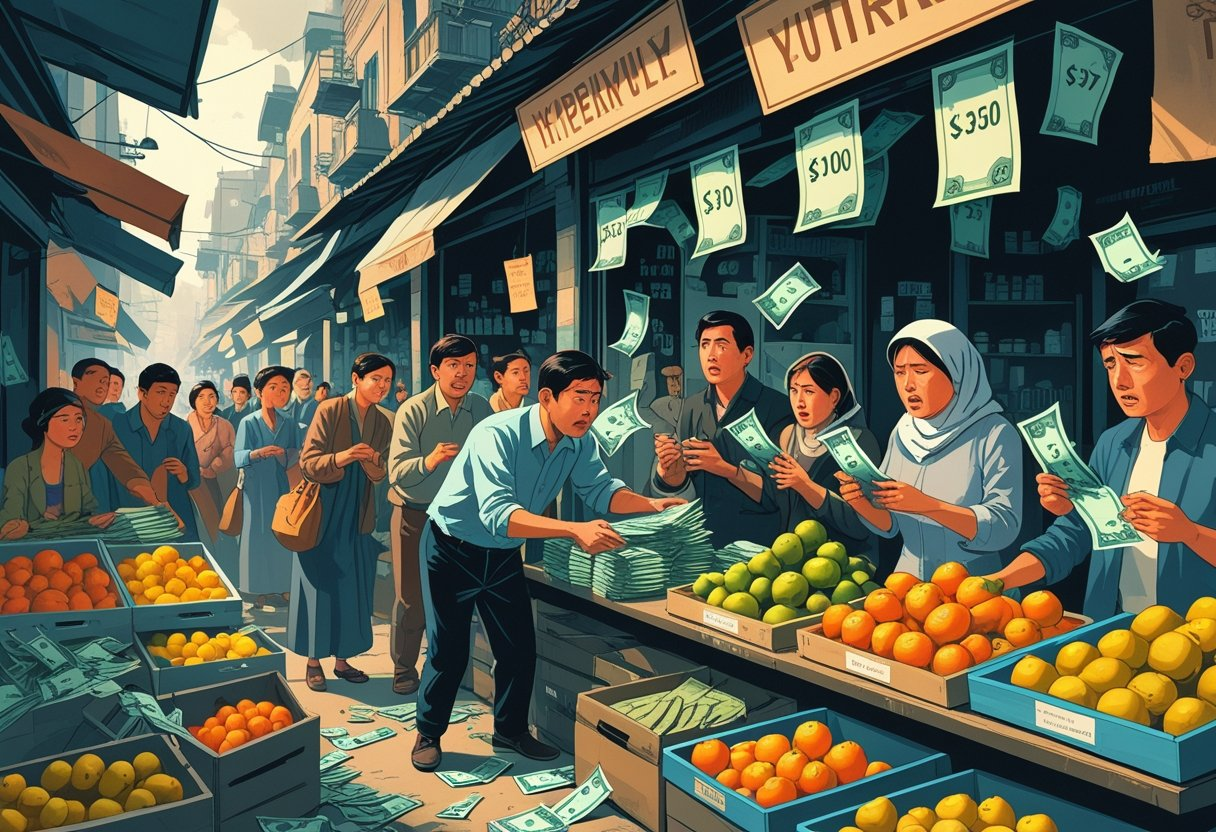Hyperinflation occurs when prices rise uncontrollably and money loses its value rapidly. This economic crisis has struck several countries throughout history, causing immense hardships for their people.
It is marked by an extreme and fast increase in prices that can destroy savings and make daily life very difficult.

Some of the worst cases of hyperinflation happened in countries like Zimbabwe, Venezuela, Germany, and Hungary. Each example shows how poor economic decisions, political instability, and external shocks can lead to financial chaos.
These stories reveal the dangers of losing control over a nation’s money supply.
What Is Hyperinflation?

Hyperinflation is a severe economic problem where prices rise extremely fast, causing money to lose value quickly. It usually happens when a country’s government prints too much money or faces other financial troubles.
This rapid price increase affects everyday life, from buying food to saving money.
Defining Hyperinflation vs. Inflation
Inflation means prices go up slowly over time, like 2% or 3% each year. This is normal in a growing economy and is often planned for.
Hyperinflation, however, is when prices increase much faster—sometimes over 50% per month. In inflation, money still holds most of its value.
With hyperinflation, the value of money drops rapidly. People need more cash to buy the same goods every day.
For example, in some cases, people have needed wheelbarrows full of cash just to buy bread.
Key Causes of Hyperinflation
Hyperinflation happens mainly when governments spend more money than they earn and cover the gap by printing money. This flood of new money decreases buying power for everyone.
Other causes include large debts and war costs, loss of faith in the national currency, poor monetary policy like lack of central bank control, and political or social instability.
These factors make prices rise faster and faster. When people stop trusting money as a store of value, they rush to spend it before it loses even more value.
Typical Economic and Social Impacts
Hyperinflation destroys savings because money loses purchasing power quickly. People’s incomes fail to keep up with rising prices, making everyday life harder.
It can cause shortages of food and goods since businesses cannot set stable prices. This leads to social unrest, protests, and sometimes violence.
Governments often lose control over their economies during hyperinflation. To regain stability, countries may introduce new currencies or seek international aid to rebuild trust.
The Weimar Republic: Germany’s 1923 Crisis

The economic collapse in Germany in 1923 was caused by heavy debt from war reparations, extreme inflation of the currency, and government efforts to manage the crisis by printing money. These problems led to social unrest and political instability, damaging the young Weimar Republic’s democracy.
War Reparations and Their Economic Toll
After World War I, Germany was forced to pay large sums in war reparations to the Allied powers. These payments drained the country’s financial resources.
The Treaty of Versailles specifically required these reparations to be paid in gold-backed currency, putting more pressure on the struggling Weimar government. Germany lost its overseas colonies, cutting off access to cheap raw materials.
This made it hard for the country to rebuild its economy. The reparations also limited Germany’s ability to import needed goods.
These combined factors slowed economic recovery and worsened the financial crisis.
Currency Collapse: The Fall of the German Mark
In 1923, the German Mark lost almost all its value. The government responded to debt by printing vast amounts of paper money.
This flooded the market and caused prices to rise rapidly in a cycle called hyperinflation. By November 1923, one U.S. dollar equaled 1 trillion German Marks.
Basic goods became unaffordable as prices changed hourly. People needed wheelbarrows full of money for small purchases.
Shopkeepers and farmers refused to sell goods for worthless currency, leading to shortages and social unrest.
Ending Hyperinflation: The Rentenmark Solution
The Weimar government introduced a new currency, the Rentenmark, in August 1924 to stop the chaos. The Rentenmark was backed by real assets like land, which helped restore confidence.
The government also reached agreements to reduce reparations payments to manageable levels. These steps stabilized the economy.
The Rentenmark stopped prices from spiraling out of control and helped rebuild trust in the currency and government.
Zimbabwe: The 21st Century’s Most Notorious Case
Zimbabwe’s hyperinflation crisis was driven by a mix of poor economic decisions and government policies. The Reserve Bank of Zimbabwe’s actions amplified the problem.
These factors severely affected daily life, making normal activities like shopping very difficult.
Land Reform and Economic Mismanagement
Zimbabwe’s economic troubles began largely due to land reform programs in the early 2000s. The government seized farms from white commercial farmers and redistributed land to many inexperienced small-scale farmers.
This led to a sharp drop in agricultural production, which was once a major export source. Consequently, export earnings fell, causing severe budget deficits.
Government revenues shrank while expenses rose, creating financial strain. Economic mismanagement worsened the situation.
The government failed to control spending and used money printing to cover its costs. These actions destroyed confidence in the Zimbabwean dollar and led directly to runaway inflation.
The Role of the Reserve Bank of Zimbabwe
The Reserve Bank of Zimbabwe played a central role in the hyperinflation crisis. To cover government spending and debt, it printed large amounts of the Zimbabwean dollar.
This excessive money printing flooded the market. As more money chased fewer goods, prices rose rapidly.
Inflation rates soared, reaching an estimated 89.7 sextillion percent in 2008. The bank issued ever larger banknotes, including a 100 trillion Zimbabwean dollar note.
These moves did not stop inflation but made it harder to control. The growing budget deficits and large money supply caused trust in the Zimbabwean dollar to collapse, forcing the country to abandon its currency.
Daily Life During Peak Hyperinflation
During the peak of hyperinflation, everyday life became extremely difficult for Zimbabweans. Prices doubled every few hours, making it almost impossible for people to budget or save.
Basic goods like bread, fuel, and medicine became unaffordable. People often carried large bags of banknotes to buy simple items.
Shops struggled to set prices, and shortages were common. The black market for foreign currencies grew as the Zimbabwean dollar lost value.
Social unrest increased as citizens faced hardships. Many lost their savings and jobs.
The economic chaos forced Zimbabwe to adopt foreign currencies like the U.S. dollar in 2009 to stabilize daily transactions.
Venezuela: Modern Hyperinflation Horror
Venezuela’s hyperinflation crisis is a clear example of how poor economic policies and political turmoil can dismantle a country’s economy. The collapse of the Venezuelan bolívar and mass social unrest show the severe effect on daily life caused by spiraling prices and lost currency value.
Economic Mismanagement and Money Printing
Venezuela’s economic troubles stem largely from government mismanagement and excessive money printing. The country relied heavily on oil revenues, but falling oil prices exposed weak economic planning.
To cover budget deficits, the government printed large amounts of new money, causing the Venezuelan bolívar to lose value rapidly. This unchecked increase in money supply fueled inflation that quickly turned into hyperinflation.
Experts like Steve Hanke have noted that constant money printing without backing by real assets or economic productivity destroyed confidence in the currency. Capital controls and price regulations also worsened shortages and discouraged investment, deepening the crisis.
The Collapse of the Venezuelan Bolívar
The Venezuelan bolívar’s value dropped dramatically during the crisis, losing almost all its purchasing power. In 2016, inflation was already severe, but by 2025, rates reached millions of percent annually.
This collapse made everyday transactions difficult as prices soared hour by hour. Currency became practically worthless, forcing people to use foreign currencies like the U.S. dollar for basic trade.
Repeated redenominations of the bolívar failed to restore trust. The loss of a stable currency destabilized the economy and left millions struggling with savings and incomes that could not keep up with inflation.
Human Impact: Social and Political Instability
The economic collapse sparked widespread social unrest and political instability. Basic goods like food, medicine, and hospital supplies became scarce.
Lines for essentials grew long, and poverty rates soared. Political power struggles added to the chaos.
The fight between President Nicolás Maduro and opposition leaders increased uncertainty. This tension weakened institutions and made coordinated solutions difficult.
Hyperinflation destroyed living standards, leading to mass migration and deepening social divisions. The crisis eroded trust in government and fueled violence and crime in many areas, affecting the lives of millions.
Other Notable Hyperinflation Disasters
Several historical cases of hyperinflation show how war, political upheaval, and economic policies can cause severe currency collapse. These events often involved the destruction of economic resources and attempts to fund government deficits by printing money, which caused prices to soar rapidly.
Hungary: World War II and the Forint Transition
Hungary experienced one of the worst hyperinflations after World War II. Daily inflation rates climbed as high as 207%, with prices doubling roughly every 15 hours.
The country was left economically devastated, with 40% of its capital stock destroyed during the war. Hungary’s monetary collapse was worsened by massive war reparations to the Soviet Union, which consumed up to half of the national budget.
The Allied Control Commission influenced monetary policy, pushing the government to print money despite warnings from central bankers. The crisis ended when Hungary introduced a new currency, the forint, to replace the rapidly devaluing pengő.
This transition helped stabilize prices and restore economic confidence.
Yugoslavia: The Aftermath of the Breakup
The breakup of Yugoslavia triggered severe hyperinflation from 1992 to 1994. The Federal Republic of Yugoslavia faced a daily inflation rate around 65%, with prices doubling every 34 hours.
Ethnic conflicts and economic collapse disrupted trade and industrial output. An international embargo worsened the economic situation, limiting exports and shrinking government revenue.
Despite breaking into smaller nations, the FR Yugoslavia kept much of the old bureaucratic system. This contributed to large budget deficits, which the central bank tried to cover by aggressively printing money.
The excessive money printing caused the Yugoslav dinar to devalue rapidly. Hyperinflation ended only after the introduction of a new currency and fiscal reforms.
Lessons from Less-Known Cases
Other lesser-known hyperinflation episodes reveal similar patterns. War, political instability, and heavy government spending often forced countries to print excessive money.
This caused rapid price increases and destroyed savings. Restoration of trust through new currencies and austerity policies helped several nations recover.
Avoiding unchecked money printing is a consistent lesson. In some cases, controlling inflation required strict monetary discipline combined with economic restructuring.
Lessons Learned and Prevention Strategies
Hyperinflation results from deep economic and political problems. Stabilizing an economy requires strict control over spending and careful reform efforts.
Preventing hyperinflation depends heavily on managing money supply and addressing political causes of economic instability.
Role of Monetary Policy and Economic Reforms
Monetary policy must be disciplined to avoid excessive money printing, which directly fuels hyperinflation. Independent central banks play a key role by resisting political pressure to finance government deficits through money creation.
Economic reforms should focus on reducing budget deficits through improved tax collection and cutting unnecessary spending. Introducing new currencies or currency boards can restore confidence when inflation spirals out of control.
Clear communication of policy goals and inflation targets helps anchor public expectations. Transparency in government finances promotes trust and discourages the rapid loss of currency value.
Consequences of Political Instability and Poor Governance
Political instability often triggers hyperinflation by disrupting normal fiscal management.
Wars, revolutions, or corrupt governments can cause sudden spending increases and reduced tax revenues, forcing money creation to fill gaps.
Poor governance undermines trust in institutions.
This loss of trust can cause people to rush to spend money, increasing inflation’s velocity.




Leave a Reply